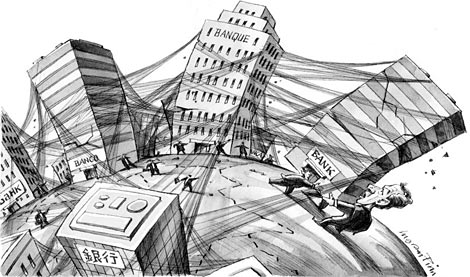MERGERS, ACQUISITIONS AND ... TOO BIG TO FAIL? A POSSIBLE FUTURE FOR THE ANGOLAN BANKING SECTOR
THE TOO BIG TO FAIL RISK
Due to BNA Notice No.
02/18 on the adequacy of minimum social capital and regulatory capital
of banks, which requires their increase, there has been much speculation
about the possibility of a wave of mergers and acquisitions (mainly
mergers) in the near future of the angolan banking subsector. However,
little or nothing has been mentioned about the risk of it resulting in
potentially large Banks that could represent massive systemic risks: the
Too Big to Fail.
A Too Big to Fail bank, is a banking institution
whose size and influence on the economic system, would be so
significant that if it became insolvent, the economy would suffer
severely. Bank size, complexity and interconnection with other banks may
inhibit the Government's ability to resolve the bank without
significant disruption to the financial system or the economy (see the
subprime crisis in 2008, where the fall of Lehman Brothers triggered the
recent global financial crisis and whose consequences are still felt).
The risk of bankruptcy of a “Too Big to Fail” increases the probability
of a bailout by the Government, which often means, as we have seen in
other realities, times of austerity. It should be recalled that in the
case of Angola, although the Deposit Guarantee Fund has recently been
materialized under Presidential Decree No. 195/18 of August 22nd (which
is positive), the Resolution Fund has not (at least not yet), which
makes our financial system still vulnerable in case a Too Big to Fail
institution needs to be "rescued".
These Too Big to Fail banks
may arise amongst us if these operations are not closely monitored (and
very cautiously) by the regulator. And as experiences of other realities
have already demonstrated, institutions of this nature can have
devastating effects on the financial system, which should preferably be
avoided.
If the risk of this scenario becomes significant, the
regulator may, as a preventive measure, intervene and mediate these
M&A operations, in order to ensure that one or more institutions
will not take on the risk of converting them into risk centers,
potentially unbearable for the financial system.
Such
intervention may also involve, if necessary, the creation of new
regulatory instruments aimed at limiting the ability of banking
financial institutions to concentrate their risk; impose new capital
requirements (again) which may even be progressive in nature; the
creation of a category of "systemically relevant financial
institutions"; the establishment of specific and more stringent
continuous monitoring mechanisms; oblige banking institutions to develop
mechanisms that enable them to quickly liquidate assets in the event of
insolvency; the development of a complex structure of settlement and
deposit-guarantee mechanisms so that, in the event of insolvency
(whether it is a Too Big to Fail or not), it serves as a buffer against
the impact on the financial system; and the creation of communication
channels that facilitate a direct consultation with the regulator, in
what concerns to matters that can influence the systemic risk that these
institutions represent.
In this approach, the fundamental
concern will be the definition of frameworks that guarantee the
economic-financial equilibrium of institutions, preventing (or
controlling) their involvement in other entities whose eventual collapse
could have a negative repercussion on the participants themselves and,
in a more comprehensive plan, in the national economy, through the
so-called domino effect.
As we can see, the intervention of the
regulator is necessary to ensure the stability of the financial system
during and after the completion of these merger and acquisition
operations that may (and most likely will) reconfigure our financial
system and, in particular, the banking subsector.
THE SUBPRIME CRISIS
In
conclusion, it is worth recalling, very briefly, the origins of the
2008 financial crisis, which serves as a reminder of the risks of Too
Big to Fail institutions.
This resulted from market failures and regulatory failures.
The
market failure occurred because wealth (or capital) holders did not, in
many cases, take the necessary precautions to protect their interests.
Several companies established compensation structures that rewarded
excessive risk.
Banks "bought mortgages", even with the knowledge that the criteria for granting housing loans were not very strict.
At
the same time, several regulators (recalling that this had
international proportions and occurred in a number of markets) took on
"more relaxed" postures in the performance of their duties, despite the
alerts by a number of experts about the risk of a crisis with the same
nature of the crisis of 2008 (some date back to the 1990s). As noted,
such alerts were ignored.
Originally published in 05/10/2018 on Jornal Mercado.
Elaborated by: Elvis Barros



Comentários
Enviar um comentário